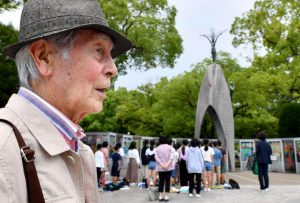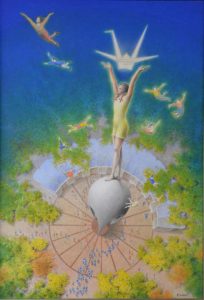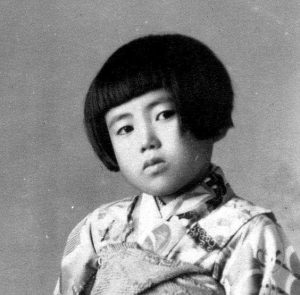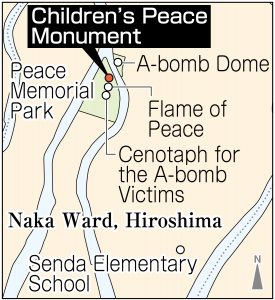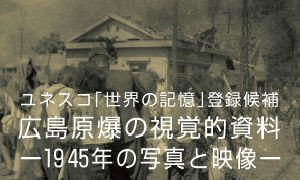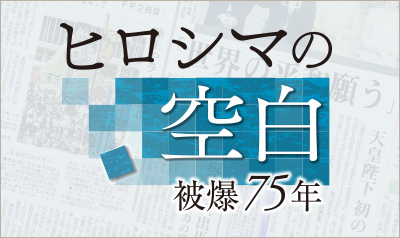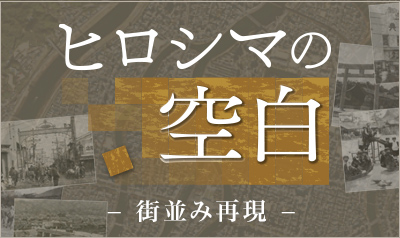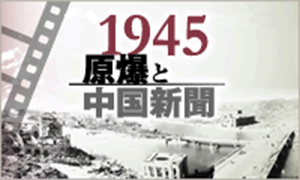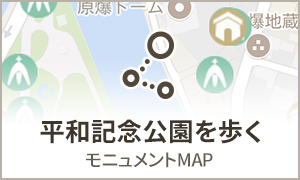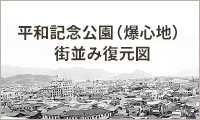Kimihisa Ogawa, designer of paper-crane booth in Peace Park, creates painting of classmate who died from leukemia after A-bombing — “She is Sadako to me”
23年8月5日
by Kyosuke Mizukawa, Senior Staff Writer
The Children’s Peace Monument, located in Hiroshima’s centrally located Naka Ward, was modeled on Sadako Sasaki, a young girl who continued to fold paper cranes until her death of leukemia in hopes of recovery from the disease. Many people visit the children’s monument from Japan and overseas, but Kimihisa Ogawa, 82, a resident of the city’s Naka Ward who designed the booth for paper-crane offerings that stands next to the monument, recently recalled at the site a former classmate whose future was taken by leukemia. Mr. Ogawa created a painting of his classmate that conveys the importance of the lives that were lost.
Last summer, Mr. Ogawa visited the Children’s Peace Monument in Naka Ward’s Peace Memorial Park. “As I imagined, this place reminds me of Hiroko,” he explained with emotion.
Hiroko Miyahara died of leukemia at the age of 10. Hiroko was Mr. Ogawa’s classmate at Senda Elementary School (in what is now Naka Ward), which he started attending in 1948. “She was a smart girl. She and I were in the same class until fifth grade. She was my closest friend among the girls at school,” said Mr. Ogawa. When they were fifth-grade students, Mr. Ogawa was class president, and Hiroko was vice president. Together, they engaged in the creation of a wall newspaper after school hours.
Hiroko began to miss school some time in fifth grade. Mr. Ogawa assumed she would soon return to class, but she had been diagnosed with leukemia, a disease that was difficult to treat, and admitted to the Hiroshima Red Cross Hospital.
Seven years had passed after her experience in the atomic bombing, but that was around the peak in increased leukemia cases caused by A-bomb radiation. At the age of three, Hiroko experienced the atomic bombing near her home, located about 1.1 kilometers from the hypocenter. Her father was killed in the bombing.
Hiroko’s mother desperately cared for her daughter, but Hiroko died at the age of 10 in October of that year. After she died, Mr. Ogawa learned that the cause of death was “A-bomb disease,” or specifically “leukemia.” He felt deep remorse.
Mr. Ogawa attended college in Tokyo and started work in the capital city at the office of the late Kenzo Tange, the architect who designed Peace Memorial Park in Hiroshima. He was involved in a project to develop facilities in the park, including the Flame of Peace, which was completed in 1964.
Later, he returned to Hiroshima, becoming an independent architect. Consigned by the Hiroshima City government, he designed the paper-crane booth near the Children’s Peace Monument. The booth, of a semi-circle shaped design, partially surrounds the monument. It was completed in 2002.
Seeing the monument firsthand brought up memories for Mr. Ogawa of his deceased classmate Hiroko, but those thoughts had never before come into focus. Six years ago, after devoting time to his love of painting since turning 70, he made the determination to create his own interpretive painting of the Children’s Peace Monument. The result was a painting of the statue of a young girl using Hiroko as a model.
Mr. Ogawa’s painting is displayed at the Peace Archives in Noboricho Elementary School, in Hiroshima’s Naka Ward. His friend, Kikuo Okabe, 74, who serves as a volunteer guide for the archives, suggested that Mr. Ogawa exhibit the painting there, a proposal to which he instantly agreed. Information about the onset of Hiroko’s leukemia is described on a nearby explanatory panel that describes how Sadako, who also attended Noboricho Elementary School, was not the only victim of the bombing.
“It is natural and important that each individual have their own impression of ‘Sadako,’” Mr. Ogawa said, sharing how his own memories have shaped his view of the Children’s Peace Monument. Many children whose names are not known like Sadako’s also perished in the atomic bombing. He hopes the monument can serve as a place to mourn those lives.
Keywords
Children’s Peace Monument
The Children’s Peace Monument was erected in 1958 with the aim of providing comfort to the souls of the many children who had lost their lives in the atomic bombing and as a call for world peace. A campaign to establish the monument was initiated by classmates of Sadako Sasaki, who had experienced the atomic bombing at the age of two and died of leukemia in 1955 when she was 12, resulting in donations from people throughout Japan. A bronze figure of a young girl holding a paper crane stands atop the monument.
(Originally published on August 5, 2023)
The Children’s Peace Monument, located in Hiroshima’s centrally located Naka Ward, was modeled on Sadako Sasaki, a young girl who continued to fold paper cranes until her death of leukemia in hopes of recovery from the disease. Many people visit the children’s monument from Japan and overseas, but Kimihisa Ogawa, 82, a resident of the city’s Naka Ward who designed the booth for paper-crane offerings that stands next to the monument, recently recalled at the site a former classmate whose future was taken by leukemia. Mr. Ogawa created a painting of his classmate that conveys the importance of the lives that were lost.
Last summer, Mr. Ogawa visited the Children’s Peace Monument in Naka Ward’s Peace Memorial Park. “As I imagined, this place reminds me of Hiroko,” he explained with emotion.
Hiroko Miyahara died of leukemia at the age of 10. Hiroko was Mr. Ogawa’s classmate at Senda Elementary School (in what is now Naka Ward), which he started attending in 1948. “She was a smart girl. She and I were in the same class until fifth grade. She was my closest friend among the girls at school,” said Mr. Ogawa. When they were fifth-grade students, Mr. Ogawa was class president, and Hiroko was vice president. Together, they engaged in the creation of a wall newspaper after school hours.
Hiroko began to miss school some time in fifth grade. Mr. Ogawa assumed she would soon return to class, but she had been diagnosed with leukemia, a disease that was difficult to treat, and admitted to the Hiroshima Red Cross Hospital.
Seven years had passed after her experience in the atomic bombing, but that was around the peak in increased leukemia cases caused by A-bomb radiation. At the age of three, Hiroko experienced the atomic bombing near her home, located about 1.1 kilometers from the hypocenter. Her father was killed in the bombing.
Hiroko’s mother desperately cared for her daughter, but Hiroko died at the age of 10 in October of that year. After she died, Mr. Ogawa learned that the cause of death was “A-bomb disease,” or specifically “leukemia.” He felt deep remorse.
Mr. Ogawa attended college in Tokyo and started work in the capital city at the office of the late Kenzo Tange, the architect who designed Peace Memorial Park in Hiroshima. He was involved in a project to develop facilities in the park, including the Flame of Peace, which was completed in 1964.
Later, he returned to Hiroshima, becoming an independent architect. Consigned by the Hiroshima City government, he designed the paper-crane booth near the Children’s Peace Monument. The booth, of a semi-circle shaped design, partially surrounds the monument. It was completed in 2002.
Seeing the monument firsthand brought up memories for Mr. Ogawa of his deceased classmate Hiroko, but those thoughts had never before come into focus. Six years ago, after devoting time to his love of painting since turning 70, he made the determination to create his own interpretive painting of the Children’s Peace Monument. The result was a painting of the statue of a young girl using Hiroko as a model.
Mr. Ogawa’s painting is displayed at the Peace Archives in Noboricho Elementary School, in Hiroshima’s Naka Ward. His friend, Kikuo Okabe, 74, who serves as a volunteer guide for the archives, suggested that Mr. Ogawa exhibit the painting there, a proposal to which he instantly agreed. Information about the onset of Hiroko’s leukemia is described on a nearby explanatory panel that describes how Sadako, who also attended Noboricho Elementary School, was not the only victim of the bombing.
“It is natural and important that each individual have their own impression of ‘Sadako,’” Mr. Ogawa said, sharing how his own memories have shaped his view of the Children’s Peace Monument. Many children whose names are not known like Sadako’s also perished in the atomic bombing. He hopes the monument can serve as a place to mourn those lives.
Keywords
Children’s Peace Monument
The Children’s Peace Monument was erected in 1958 with the aim of providing comfort to the souls of the many children who had lost their lives in the atomic bombing and as a call for world peace. A campaign to establish the monument was initiated by classmates of Sadako Sasaki, who had experienced the atomic bombing at the age of two and died of leukemia in 1955 when she was 12, resulting in donations from people throughout Japan. A bronze figure of a young girl holding a paper crane stands atop the monument.
(Originally published on August 5, 2023)

